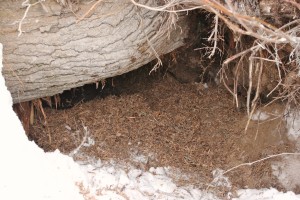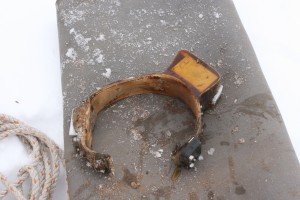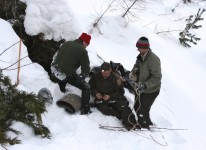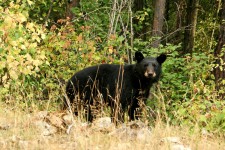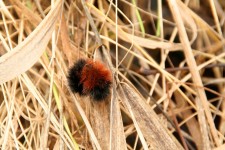Carefully I crawl into the entrance of a bear den to take a look at the black bear. Laying on a bed of dried ferns, she was only inches away–the closest I’ve ever been to a black bear. Even though she was sedated, I didn’t linger long because I knew two yearlings were wide awake farther back in the den.
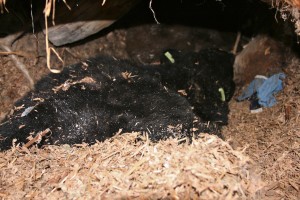
Inside the den, the black bear rests with her head away from the entrance. Her two ear tags are visible along with the blue blindfold biologists used when taking off her GPS collar.
I was lucky enough to be accompanying three biologists retrieving a GPS collar on this female bear.
The end of January and the beginning of February is the ideal time to retrieve a collar from a black bear. They are the most lethargic at this point and will go back to sleep more readily.
However, we approached the den as quietly as possible because black bears can easily be awakened since they are not true hibernators. They only drop their body temperature 12 to 14 degrees Fahrenheit in the winter (to around 88 degrees Fahrenheit). Just digging snow away from the entrance caused the female to start shivering, which meant she was preparing to wake up to defend herself.
She fought the drugs for nearly an hour, moving about the den as she did (a tarp over the entrance deterred her from coming out). By this point the two yearlings were awake and one tried to escape over the biologist who was cutting off the female’s collar.
The yearlings will stay with their mother until this spring when she drives them away so she can mate. Black bears have a two year breeding interval. A female will mate in the spring, give birth the beginning of February, raise the cubs over the summer and fall, and den with them that winter.
This female black bear and her cubs decided to den in a spacious hole under the roots of a fallen tree. Black bears also commonly den in brush piles or hollow trees but they typically won’t reuse a den.
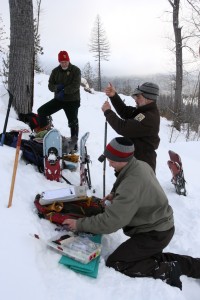
Biologists preparing the drugs to sedate the bear. They staged away from the den, visible behind the farthest biologist, to minimize noise.
The den isn’t barren; black bears bring in grass and leaves to curl up on. In this den, she was laying on dried fern fronds and shredded cedar bark. The biologists have also seen beds of dried bear grass.
When the biologists first saw the female bear in the den, she was quite close to the opening, giving the impression the den was small. Her thick layer of fat and thick fur (which doubles in insulative value in the winter) was keeping her warm.
For being curled up in a den from November to mid-April, the den didn’t smell at all, besides the earthy smell of disturbed dirt. Black and grizzly bears don’t defecate or urinate while hibernating. They also don’t eat or drink.
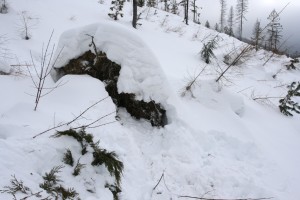
Biologists covered the entrance to the bear den with snow so the sow wouldn’t think it was spring when she woke up from the drugs.
Their bodies are uniquely adapted to process the fat they burn, and break down and reabsorb their urine back into the body so nothing is wasted.
In order to have enough fat reserves for winter, they gorge themselves on berries, especially huckleberries, and other food before they den. If the food supply is low, black bears will den sooner, as early as October. They don’t den to escape the cold, but because of the dwindling food supply.
Come mid-April when they awaken and emerge from the den, the female probably won’t remember our encounter but I sure will.
Read more information on this black bear research project.

